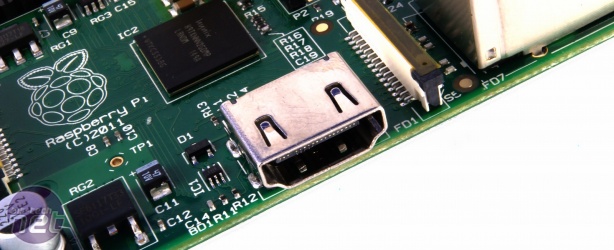Raspberry Pi review
April 16, 2012 | 14:24
Companies: #arm #broadcom #hynix #raspberry-pi #raspberry-pi-foundation

You may remember from our talk with founder Eben Upton that overclocking the Raspberry Pi is considered ill-advised. 'This is a mobile phone chip,' Upton explained. 'The voltage this chip runs at, you can't just give it a significant voltage overhead without harming the overall chip lifetime.'
If you thought that was going to put us off, however, you've probably forgotten what site you're reading. Anxious to see just how much overhead the Broadcom BCM2835 really has, we started playing with config.txt.
The config.txt file, located on the boot partition of the SD card, takes the place of a traditional BIOS. In it, you can specify various configuration options that the SoC should pay attention to at power on. While its primary use is to adjust overscan settings when using the composite video output, it also allows you to overclock and overvolt the memory, CPU and GPU.
At this point, we'd like to mention that it's perfectly possible to brick a Raspberry Pi by overclocking it, and that even attempting to do so sets a fuse within the SoC that means your warranty is toast - even if the device isn't. With Pis in such short supply, we'd recommend waiting until it's possible to buy a replacement before trying this yourself.
To start, we adjusted the core CPU clock from 700MHz to 800MHz, while boosting the RAM clock to 420MHz from 400MHz. The result: the SysBench benchmark reported a drop from 106.72ms per request to 93.07ms - proving, if there were any doubt, that the synthetic SysBench CPU test scales in a linear fashion.
Going a step further, we clocked the system up to 900MHz while boosting RAM to 440MHz - dangerous levels for a chip with little overhead. Nevertheless, the system booted fine and the benchmark dropped to 81.93ms.
At all times, the BCM2835 remained lukewarm to the touch - which is why were were fairly disappointed that an attempt to break a barrier with a CPU speed of 1GHz failed miserably. At 1GHz, the system refused to boot altogether.
The overclockability of individual Pis varies to a staggering degree, however: we were lucky to hit 900MHz, with others reporting that 800MHz is the hard limit for their boards. Whether there are any systems out there that could hit 1GHz with a bit of a voltage poke remains to be seen.
If you thought that was going to put us off, however, you've probably forgotten what site you're reading. Anxious to see just how much overhead the Broadcom BCM2835 really has, we started playing with config.txt.
The config.txt file, located on the boot partition of the SD card, takes the place of a traditional BIOS. In it, you can specify various configuration options that the SoC should pay attention to at power on. While its primary use is to adjust overscan settings when using the composite video output, it also allows you to overclock and overvolt the memory, CPU and GPU.
At this point, we'd like to mention that it's perfectly possible to brick a Raspberry Pi by overclocking it, and that even attempting to do so sets a fuse within the SoC that means your warranty is toast - even if the device isn't. With Pis in such short supply, we'd recommend waiting until it's possible to buy a replacement before trying this yourself.
To start, we adjusted the core CPU clock from 700MHz to 800MHz, while boosting the RAM clock to 420MHz from 400MHz. The result: the SysBench benchmark reported a drop from 106.72ms per request to 93.07ms - proving, if there were any doubt, that the synthetic SysBench CPU test scales in a linear fashion.
Going a step further, we clocked the system up to 900MHz while boosting RAM to 440MHz - dangerous levels for a chip with little overhead. Nevertheless, the system booted fine and the benchmark dropped to 81.93ms.
At all times, the BCM2835 remained lukewarm to the touch - which is why were were fairly disappointed that an attempt to break a barrier with a CPU speed of 1GHz failed miserably. At 1GHz, the system refused to boot altogether.
The overclockability of individual Pis varies to a staggering degree, however: we were lucky to hit 900MHz, with others reporting that 800MHz is the hard limit for their boards. Whether there are any systems out there that could hit 1GHz with a bit of a voltage poke remains to be seen.

MSI MPG Velox 100R Chassis Review
October 14 2021 | 15:04









Want to comment? Please log in.